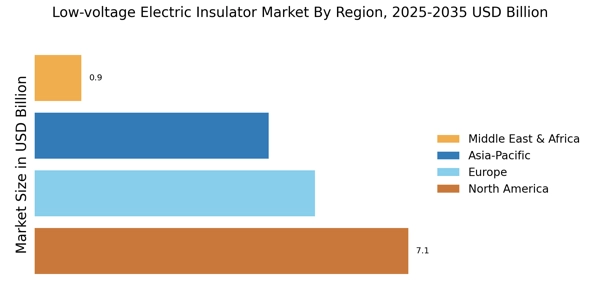Rising Demand for Renewable Energy
The increasing emphasis on renewable energy sources, such as solar and wind, is driving the Low-voltage Electric Insulator Market. As more countries invest in renewable energy infrastructure, the need for reliable electrical components, including low-voltage insulators, becomes paramount. For instance, the International Energy Agency reported a significant rise in renewable energy capacity, which necessitates the use of effective insulation solutions to ensure safety and efficiency. This trend is likely to continue, as governments and private sectors prioritize sustainable energy solutions, thereby expanding the market for low-voltage electric insulators.
Regulatory Standards and Safety Compliance
The implementation of stringent regulatory standards and safety compliance measures is influencing the Low-voltage Electric Insulator Market. Governments and regulatory bodies are increasingly mandating the use of high-quality insulation materials to enhance electrical safety and reduce hazards. This regulatory environment encourages manufacturers to innovate and improve their product offerings, thereby expanding the market. For example, compliance with international safety standards can lead to increased demand for low-voltage insulators, as companies seek to meet these requirements and ensure the safety of their electrical installations.
Urbanization and Infrastructure Development
Rapid urbanization and ongoing infrastructure development projects are contributing to the growth of the Low-voltage Electric Insulator Market. As urban areas expand, the demand for reliable electrical systems increases, necessitating the use of low-voltage insulators in residential, commercial, and industrial applications. According to recent data, urban populations are projected to grow significantly, leading to increased investments in electrical infrastructure. This trend indicates a robust market potential for low-voltage electric insulators, as they play a crucial role in ensuring the safety and reliability of electrical systems in densely populated areas.
Increased Investment in Smart Grid Technologies
The growing investment in smart grid technologies is positively impacting the Low-voltage Electric Insulator Market. Smart grids require advanced electrical components, including low-voltage insulators, to facilitate efficient energy distribution and management. As utilities and energy providers modernize their infrastructure, the demand for reliable insulation solutions is expected to rise. Reports indicate that the smart grid market is experiencing substantial growth, which could lead to increased opportunities for low-voltage electric insulator manufacturers to supply the necessary components for these advanced systems.
Technological Innovations in Insulation Materials
Technological advancements in insulation materials are reshaping the Low-voltage Electric Insulator Market. Innovations such as the development of advanced polymer materials and composite insulators are enhancing the performance and durability of low-voltage insulators. These materials offer improved resistance to environmental factors, which is crucial for maintaining electrical safety and efficiency. As manufacturers adopt these new technologies, the market is likely to witness a shift towards more efficient and reliable insulation solutions, catering to the evolving needs of the electrical industry.


















Leave a Comment